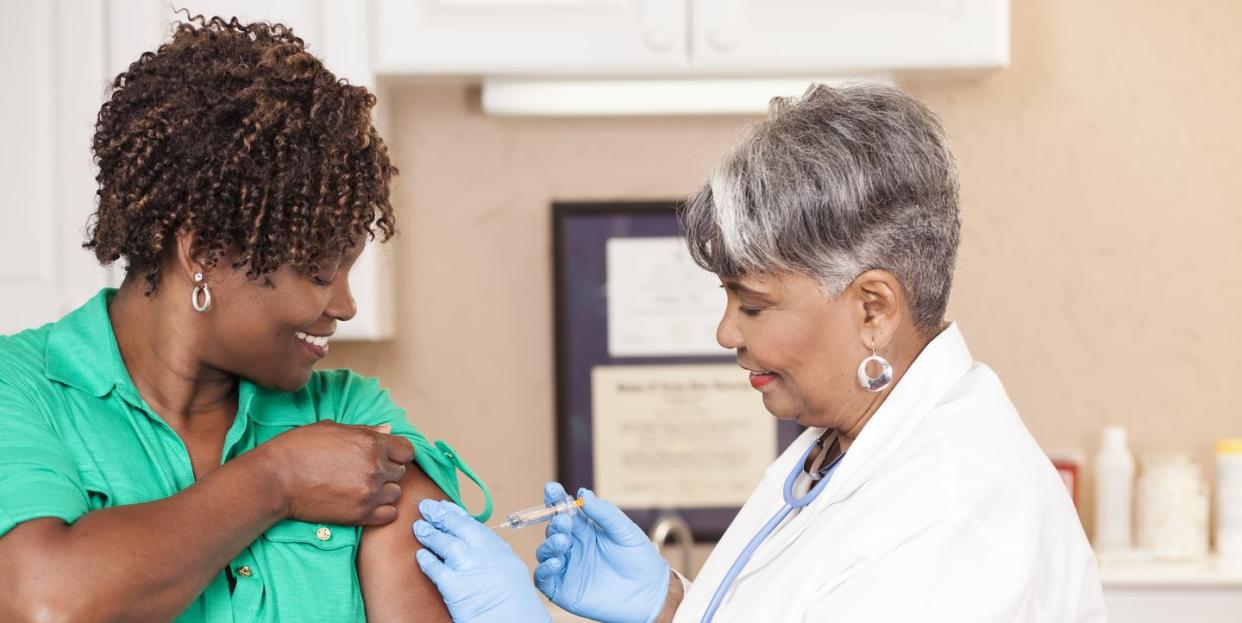Find Out Exactly What’s In the Flu Shot for 2021-2022

There’s been a lot of talk about vaccines and vaccine ingredients lately thanks to the COVID-19 vaccine. And now that flu season upon us, it’s only natural to wonder about what’s in your flu vaccine, too.
Like the COVID-19 vaccines, there are several types of seasonal flu vaccines. Some are egg-based, for example, while others are egg-free. There are also differences between the flu shot and nasal mist, and small nuances with high-dose flu vaccines and “regular” vaccines. For this flu season, the Food and Drug Administration (FDA) has released nine different “lots” of the flu vaccine, and each is slightly different with its own ingredients. Still, they have a lot in common.
“The flu vaccines are very similar in their general composition,” says infectious disease expert Amesh A. Adalja, M.D., a senior scholar at the Johns Hopkins Center for Health Security. “However, some use different technologies.”
So…what’s in your seasonal flu vaccine and why? Experts break it down.
What are the types of flu vaccines?
First, it’s helpful to know that there are three different flu production techniques approved by the FDA in the U.S.:
Egg-based vaccines
These are the most common type, according to the Centers for Disease Control and Prevention (CDC). To make these vaccines, candidate vaccine viruses (CVVs) are grown in eggs and incubated for several days to let the viruses replicate. The virus is then harvested from the eggs. For the flu shot (which is an inactivated flu vaccine), the flu is killed and the virus antigen is purified. For the nasal spray vaccine (which is a live vaccine), the virus is weakened. It’s then sent through the manufacturing process.
Cell-based vaccines
This type of vaccine uses flu viruses that have been grown in cells to make CVVs, the CDC says. They’re then injected into cultured mammalian cells, where they replicate for a few days. The virus is harvested and purified, and then undergoes the manufacturing process.
Recombinant flu vaccines
These vaccines are created synthetically and use a gene that contains genetic instructions for making a surface protein called hemagglutinin (HA) that’s found on flu viruses. HA triggers the human immune system to create antibodies that specifically target the virus, the CDC explains. It’s combined with a baculovirus, a virus that infects invertebrates, which helps transport the genetic instructions for making flu virus HA antigen into a host cell. Basically, it tells your body how to fight the flu. The antigen is grown in bulk, collected, purified, and then packaged as the recombinant flu vaccine.
What ingredients are in the 2021-2022 flu shot?
Again, every flu vaccine is slightly different, depending on the type and manufacturer. However, the FDA released the most lots of one particular vaccine, the Afluria Quadrivalent vaccine, suggesting this will be the most commonly-used flu vaccine this year. Here’s a breakdown of those ingredients:
Strains of the virus
Hemagglutinin are the actual strains of the virus that this vaccine is targeting. “Strains are chosen based on what is circulating in terms of flu viruses,” Dr. Adalja says. “Because the northern and southern hemispheres have opposite flu seasons, one may be used to influence the vaccine components of another.”
Stabilizers
Sodium chloride, monobasic sodium phosphate, dibasic sodium phosphate, monobasic potassium phosphate, potassium chloride, and calcium chloride are all “buffers,” says Jamie Alan, Ph.D., an associate professor of pharmacology and toxicology at Michigan State University. “They keep the vaccine stable in storage,” she explains.
Immune system activator
Sodium taurodeoxycholate “is used for ‘splitting’—this is a way to activate the immune system without giving adjuvant,” Alan says. (An adjuvant, in case you’re not familiar with it, is an ingredient that can be used to create a stronger immune response.)
Ingredients that appear in residual amounts
Ovalbumin is used to grown enough of the components of the vaccine
Sucrose is another stabilizer
Neomycin sulfate and polymyxin B are used to prevent contamination
Beta-propiolactone is used to inactivate the virus
Hydrocortisone is used to grow components of the vaccine
Again, each vaccine is slightly different so if you’ve had an allergy to one of a flu vaccine component in the past, it’s a good idea to ask your doctor about the ingredients list in the vaccine they plan to give you this year.
Is the flu vaccine safe?
The CDC recommends that everyone aged six months and older get vaccinated against the flu each year, noting that it's "the best way to reduce your chances of getting the seasonal flu and spreading it to others."
And yes, experts agree, the flu vaccine is safe. “Unless you have an allergy to any of the components, the flu vaccine is very safe,” Alan says. And, because it comes up every year, Alan notes that, “you cannot get the influenza virus from the injected form of the flu vaccine.”
Dr. Adalja stresses the importance of getting your seasonal flu vaccine. “The seasonal flu vaccine is the best way to keep yourself safe against influenza,” he says. “It is highly effective at preventing the severe complications of influenza, particularly death.”
If you have any questions about the seasonal flu vaccine or its ingredients, talk to your doctor. They should be able to help address your concerns.
You Might Also Like

